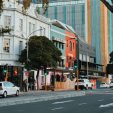Launched in Cape Town, now off to Paris, before returning to SA late 2025
Inside the Cape Town Carnival
It’s all about ghoema, the beating heart of Carnival
Every year on the 2nd of January you see minstrel troupes parading through central Cape Town. But what’s the deal with the Cape Town Carnival
The book “One Love, Ghoema Beat! Inside the Cape Town Carnival” by John Edwin Mason takes readers behind the scenes of one of the world’s least known and most colourful carnivals. The Cape Town Carnival is unique in its history, which is rooted in South Africa’s troubled past. Also the music is unique itself – it is propelled by the mesmerizing ghoema beat.
John Edwin Mason teaches African history and history of photography at the University of Virginia in Charlottesville in the United States. He has written extensively on the history of Cape Town, therefore he’s definitely an expert when it comes to African traditions and the New Year Carnival. He joined the “Pennsylvanians Crooning Minstrels” in 2007 and spent three Carnival seasons with them. He became an ‘honorary member’ of the troupe which means that he was an outsider with an insider’s point of view.
He took part in the troupe’s rehearsals, street marches and competitions. He also spent time with other troupes to getting to know their traditions und members. He photographed every single phase of the troupe’s life. This allowed him to document the Carnival in a way that has perhaps never been before. His pictures show the public and the private side of Carnival.
The history of Cape Town Carnival
Carnival is a celebration of life, a rite of renewal, and a festival of music - involving minstrel troupes, Malay choirs, and Christmas bands. In many ways, the Cape Town New Year’s Carnival is similar to Carnival in Rio de Janeiro, and Mardi Gras, in New Orleans. Unlike those events, however, it’s not tied to the Christian calendar. It owes its timing to Emancipation Day – the day on which the slaves were freed in South Africa, in the 1830s.
The Carnival’s roots reach back into the eighteenth and nineteenth centuries. At that time slaves were an important part of Cape Town’s musical life. Wealthy slave owners often gloried in small orchestras composed of their slaves, and accounts from the era tell us that the slaves performed European classical and popular music at a high level. Slaves also played for themselves. These enslaved musicians had incorporated music influences from all over the world to create a unique style that was called ghoema (after the local drum that sets the rhythm).
In the 1830s, slaves celebrated freedom - Emancipation Day - with street processions that were accompanied by bands of musicians. It’s possible that this was an extension of an already existing tradition of parading through the streets at the New Year. In any case, former slaves and their Coloured descendants continued to commemorate Emancipation Day with music throughout the nineteenth century. By the end of the nineteenth century, informal groups of Coloured musicians and singers routinely promenaded through the streets of Cape Town in celebrations that blended the commemoration of Emancipation Day with the birth of the New Year.
Ghoema – the drum, the rhythm and the sensibility
For Cape Town’s servants and slaves, ghoema was a symbol of life in the face of exile and oppression. But today it’s a symbol of cultural independence and continuity in the midst of segregation and apartheid. Ghoema provided the foundation on which the culture that gave birth to Carnival was built. It’s like the jazz in New Orleans or the samba in Rio de Janeiro – you can not play it, you have to feel it!
The Carnival’s music and fellowship lift troupe members out of their ordinary routines and take them to a place where the hardships of daily life can be momentarily forgotten. But it’s also serious business. We all know the pictures of the great parades through central Cape Town on Tweede Nuwe Jaar. But what we don’t see is the perspective from within the troupe, not from the sideline. And this is exactly what makes this book so special. It’s a uniquely comprehensive look at the minstrel troupes, the band and choir rehearsals, life in the clubhouses and the making of costumes and drums – the troupes are the spiritual face of Cape Town’s Carnival.
by Susanne Klatt
For your monthly update on what’s happening in and around Cape Town, be sure to subscribe to our popular Editor's Picks Newsletter.





